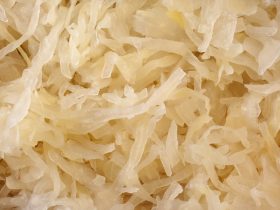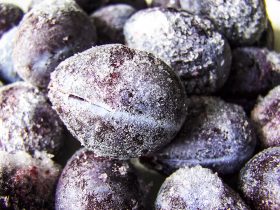Contrary to common knowledge, cantaloupe, also known as sweet-melon, is in fact a group of closely-related melon species1 that present mealy orange-flesh when cut as well as a distinctly sweet taste.
While cantaloupe is primarily consumed fresh, there are certain instances where it is used as a garnish or topping for other desserts. Because of this, it is not uncommon to need to preserve cantaloupe for certain periods of time.
Like other forms of high water-content produce, cantaloupes suffer at a cellular level when placed in a freezer. This means that once frozen, the quality of cantaloupes will decrease, both texture and taste-wise. Should you still wish to freeze your cantaloupe, certain procedures must be followed.
How Long Does Cantaloupe Last on the Counter?
Provided that the cantaloupe’s skin has not been pierced or penetrated in any significant way, your cantaloupe will last up to seven days in a room with ordinary conditions.
In the event that the cantaloupe’s skin has been compromised, or perhaps the entire fruit has been sliced, it will only last a short three to four hours at room temperature.
Note that rooms with high humidity or a higher temperature than 68–72 °F will hasten the spoilage of your melon, regardless of whether the skin is intact or not. This is due to warm temperatures and moisture catalyzing the development of microbiological life2.
Can You Refrigerate Cantaloupe Instead?
As freezing cantaloupe will affect its texture and taste, the second best option is to instead refrigerate your melon. This is essential in the event that the melon has already been sliced and exposed to the air.
In order to freeze your sliced cantaloupe appropriately, place the entirety of your slices into an air-tight container free of excess moisture. Note that the melon will darken over time due to the interaction between cantaloupe enzymes and oxygen. This will allow the melon slices to last for up to three days, in ideal conditions.

Alternatively, to freeze a whole cantaloupe, simply wrapping the melon in plastic or foil should be sufficient. Keeping the melon unsliced during refrigeration will preserve it for up to ten days, far longer than if it were cut open.
Equipment Needed for Storing Cantaloupe
In order to freeze your cantaloupe melon, you will need a sufficiently large enough knife, tissue paper, a baking tray and enough resealable plastic bags to contain the melon slices.
Processing the Cantaloupe
First, slice the cantaloupe into cubes or similar small shapes so as to store them conveniently. Make sure to remove the seeds if they are present, as these will be harder to pick out after freezing. If desired, separate the flesh from the melon rind, though this step is optional.
Place the melon slices onto a tissue paper lined baking tray, drying the surface of the tray as much as possible. Keep a small amount of space between slices, and avoid pressing the fruit together. This step is to ensure that the melons do not freeze into a single clump, as well as to allow easy removal from the plastic bags.
After separating the slices, place the tray uncovered into the freezer for approximately thirty minutes.
Freezing the Cantaloupe
Remove the now frozen slices of cantaloupe from the tray and place into separate plastic bags, keeping an inch of open air between the melon and the opening of the bag. This space will be filled in case the melons expand over time.
Place the filled bags into the freezer, away from anywhere they may be crushed or punctured.
Removing the Cantaloupe from the Freezer
While the ideal way to defrost your cantaloupe is to remove it from the freezer and instead transfer it to the fridge for up to eight hours, there may come a time where you will need the melon slices sooner.
In this particular circumstance, first ensure that the bag is free of any tears or holes that may compromise the melon. After seeing to this, fill a bowl with room temperature water from the tap and submerge the bag beneath the water.
Change out the water within the bowl every twenty minutes, making sure that it is not too warm, as this will contribute to the loss of textural quality. The melons should be defrosted enough for eating within an hour, or three cycles of soaking.
How Long will Cantaloupe Last in the Freezer?
If following the procedures within this article, the sliced cantaloupe should last up to an entire year, though the loss of texture and color will take place sooner than that span of time.
Keep in mind that there is truly no replacement for fresh produce, and freezing your cantaloupe is only an alternative to purchasing them fresh when needed.
Is Pre-freezing the Cantaloupe on a Baking Tray Necessary?
No, first placing and freezing the cantaloupe on a baking tray is not a necessary step to this process. If pressed for time, simply placing the sliced melons in a bag will more than suffice.
However, this may produce clumps of melon that have been frozen together, or even fastened to the inside of the bag. If the melon is being preserved for purposes such as smoothies or grating, pre-freezing it is not needed.
Signs of Spoilage in Cantaloupe
In the unlikely event that your cantaloupe has begun to spoil during preservation, there are several clear signs.
First, an unusual odor emanating from the flesh of the fruit is a clear sign that the melon requires disposal. Apart from foul smells, the presence of mold or fungal growths along the surface or even on the flesh is a sure-fire sign of spoilage.
A slight darkening of color as well as mushy texture is entirely normal if you have frozen the cantaloupe, however, as this is simply the result of cell-damage from freezing as well as the effect of the melon’s own enzymes.
References:
1. Kirkbride, J. H., Jr. (1993) Biosystematic monograph of the genus Cucumis (Cucurbitaceae) Parkway Publishers, Inc.
2. Unknown Author. (June 2017) “Danger Zone” (40 °F – 140 °F) U.S. Department of Agriculture https://www.fsis.usda.gov/food-safety/safe-food-handling-and-preparation/food-safety-basics/danger-zone-40f-140f





Hi, I'm Dom
Dom Eats was started to help other people fall in love with food. While cooking can feel intimidating, it doesn't have to be.